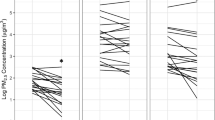Abstract
Health risks of fine particle air pollution (PM2.5) are an important public health concern that has the potential to be mitigated in part by interventions such as air cleaning devices that reduce personal exposure to ambient PM2.5. To characterize exposure to ambient PM2.5 indoors as a function of residential air cleaners, a multi-zone indoor air quality model was used to integrate spatially resolved data on housing, meteorology, and ambient PM2.5, with performance testing of residential air cleaners to estimate short-term and annual average PM2.5 of outdoor origin inside residences of three metropolitan areas. The associated public health impacts of reduced ambient PM2.5 exposure were estimated using a standard health impact assessment methodology. Estimated indoor levels of ambient PM2.5 varied substantially among ventilation and air cleaning configurations. The median 24-h average indoor–outdoor ratio of ambient PM2.5 was 0.57 for homes with natural ventilation, 0.35 for homes with central air conditioning (AC) with conventional filtration, and 0.1 for homes with central AC with high efficiency in-duct air cleaner. Median modeled 24-h average indoor concentrations of PM2.5 of outdoor origin for those three configurations were 8.4, 5.3, and 1.5 μg/m3, respectively. The potential public health benefits of reduced exposure to ambient PM2.5 afforded by air cleaning systems were substantial. If the entire population of single-family homes with central AC in the modeling domain converted from conventional filtration to high-efficiency in-duct air cleaning, the change in ambient PM2.5 exposure is estimated to result in an annual reduction of 700 premature deaths, 940 hospital and emergency room visits, and 130,000 asthma attacks in these metropolitan areas. In addition to controlling emissions from sources, high-efficiency whole-house air cleaner are expected to reduce exposure to particles of outdoor origin and are projected to be an effective means of managing public health impacts of ambient particle pollution.
This is a preview of subscription content, access via your institution
Access options
Subscribe to this journal
Receive 6 print issues and online access
$259.00 per year
only $43.17 per issue
Buy this article
- Purchase on Springer Link
- Instant access to full article PDF
Prices may be subject to local taxes which are calculated during checkout





Similar content being viewed by others
References
American Lung Association. Trends in asthma morbidity and mortality, American Lung Association, Best Practices and Programs Services, Epidemiological and Statistics Unit, 2002.
Anderson H.R., Bremner S.A., Atkinson R.W., Harrison R.M., and Walters S. Particulate matter and daily mortality and hospital admissions in the west midlands conurbation of the United Kingdom: associations with fine and coarse particles, black smoke and sulphate. Occup Environ Med 2001: 58 (8): 504–510.
AQS TTN. 2005 US EPA Air Quality System Technology Transfer Network. Retrieved July 2007, from http://www.epa.gov/ttn/airs/airsaqs.
Atkinson R.W., Bremner S.A., Anderson H.R., Strachan D.P., Bland J.M., and de Leon A.P. Short-term associations between emergency hospital admissions for respiratory and cardiovascular disease and outdoor air pollution in London. Arch Environ Health 1999: 54 (6): 398–411.
Brauner E.V., Forchhammer L., Moller P., Barregard L., Gunnarsen L., Afshari A., et al. Indoor particles affect vascular function in the aged: an air filtration-based intervention study. Am J Respir Crit Care Med 2008: 177 (4): 419–425.
Burnett R.T., Cakmak S., Brook J.R., and Krewski D. The role of particulate size and chemistry in the association between summertime ambient air pollution and hospitalization for cardiorespiratory diseases. Environ Health Perspect 1997: 105 (6): 614–620.
CDC. CDC WONDER, Centers for Disease Control and Prevention, 2007.
Chen W., Gao Z., Zhang J., Kosar D., Walker C., and Novosel D. Reduced energy use through reduced indoor contamination in residential settings, Alexandria VA, National Center for Energy Management and Building Technologies, 2006.
COMEAP. Cardiovascular Disease and Air Pollution. United Kingdom, Department of Health, Committee on the Medical Effects of Air Pollutants, 2006.
Delfino R.J., Zeiger R.S., Seltzer J.M., and Street D.H. Symptoms in pediatric asthmatics and air pollution: differences in effects by symptom severity, anti-inflammatory medication use and particulate averaging time. Environ Health Perspect 1998: 106 (11): 751–761.
Delfino R.J., Zeiger R.S., Seltzer J.M., Street D.H., and McLaren C.E. Association of asthma symptoms with peak particulate air pollution and effect modification by anti-inflammatory medication use. Environ Health Perspect 2002: 110 (10): A607–A617.
Desqueyroux H., Pujet J.C., Prosper M., Squinazi F., and Momas I. Short-term effects of low-level air pollution on respiratory health of adults suffering from moderate to severe asthma. Environ Res 2002: 89 (1): 29–37.
Dockery D.W., Pope C.A. III, Xu X., Spengler J.D., Ware J.H., Fay M.E., et al. An association between air pollution and mortality in six US cities. N Engl J Med 1993: 329 (24): 1753–1759.
Echols S.L., MacIntosh D.L., Hammerstrom K.A., and Ryan P.B. Temporal variability of microenvironmental time budgets in Maryland. J Exp Analy Environ Epidemiol 1999: 9 (5): 502–512.
Emmerich S., and Nabinger S. Measurement and Simulation of the IAQ Impact of Particle Air Cleaners in a Single-Zone Building. National Institute of Standards and Technology, Gaithersberg MD, 2000.
Emmerich S.J., Nabinger S., Gupte A., Howard-Reed C., and Wallace L. Comparison of Measured and Predicted Tracer Gas Concentrations in a Townhouse. National Institute of Standards and Technology, Gaithersburg MD, 2003.
Enermodal. Characterization of Framing Factors for Low-Rise Residential Building Envelopes., final report prepared for ASHRAE, Atlanta, GA (USA), 2001.
EPA. The Benefits and Costs of the Clean Air Act: 1990 to 2010. Office of Air and Radiation, Washington, D.C., 1999.
EPA. Air Quality Criteria for Particulate Matter (October 2004). US Environmental Protection Agency, Washington, D.C., 2004.
EPA. Regulatory Impact Analysis for the Final Clean Air Interstate Rule. US Environmental Protection Agency, Office of Air and Radiation, Washington, DC, 2005.
Franklin M., Zeka A., and Schwartz J. Association between PM2.5 and all-cause and specific-cause mortality in 27 US communities. J Expo Sci Environ Epidemiol 2007: 17 (3): 279–287.
Gwynn R.C., Burnett R.T., and Thurston G.D. A time-series analysis of acidic particulate matter and daily mortality and morbidity in the Buffalo, New York, region. Environ Health Perspect 2000: 108 (2): 125–133.
Gwynn R.C., and Thurston G.D. The burden of air pollution: impacts among racial minorities. Environ Health Perspect 2001: 109 (Suppl 4): 501–506.
Hagen J.A., Nafstad P., Skrondal A., Bjorkly S., and Magnus P. Associations between outdoor air pollutants and hospitalization for respiratory diseases. Epidemiology 2000: 11 (2): 136–140.
Haghighat F., and Rao J. A comprehesive validation of two airflow models - COMIS and CONTAM. Indoor Air 1996: 6 (4): 278–288.
Hanninen O.O., Palonen J., Tuomisto J.T., Yli-Tuomi T., Seppanen O., and Jantunen M.J. Reduction potential of urban PM2.5 mortality risk using modern ventilation systems in buildings. Indoor Air 2005: 15 (4): 246–256.
Howard-Reed C., Nabinger S., and Emmerich S.J. Predicting the Performance of Non-Industrial Gaseous Air Cleaners: Measurements and Model Simulations from a Pilot Study. National Institute of Standards and Technology, Gaithersburg MD, 2004.
Howard-Reed C., Nabinger S., and Emmerich S.J. Characterizing gaseous air cleaner performance in the field. Build Environ 2008: 43 (3): 368–377.
HUD. The American Housing Survey for the United States. US Department of Housing and Urban Development, US Department of Commerce, Washington, DC, 1999.
Industrial Economics. Expanded Expert Judgment Assessment of the Concentration–Response Relationship Between PM2.5 Exposure and Mortality. Prepared for Office of Air Quality Planning and Standards, US Environmental Protection Agency, Cambridge, MA, 2006.
Janssen N.A., Schwartz J., Zanobetti A., and Suh H.H. Air conditioning and source-specific particles as modifiers of the effect of PM(10) on hospital admissions for heart and lung disease. Environ Health Perspect 2002: 110 (1): 43–49.
Jerrett M., Burnett R.T., Ma R., Pope C.A. III, Krewski D., Newbold K.B., et al. Spatial analysis of air pollution and mortality in Los Angeles. Epidemiology 2005: 16 (6): 727–736.
Johnson T A Guide to Selected Algorithms, Distributions, and Databases Used in Exposure Models Developed by The Office Of Air Quality Planning and Standards. US Environmental Protection Agency, Office of Research and Development, Research Triangle Park NC, 2002.
Klepeis N.E., Nelson W.C., Ott W.R., Robinson J.P., Tsang A.M., Switzer P., et al. The National Human Activity Pattern Survey (NHAPS): a resource for assessing exposure to environmental pollutants. J Exp Anal Environ Epidemiol 2001: 11 (3): 231–252.
Laden F., Schwartz J., Speizer F.E., and Dockery D.W. Reduction in fine particulate air pollution and mortality: extended follow-up of the Harvard Six Cities Study. Am J Respir Crit Care Med 2006: 173 (6): 667–672.
Lansari A., Streicher J., Huber A., Crescenti G., Zweidinger R., Duncan J., et al. Dispersion of automotive alternative fuel vapors within a residence and its attached garage. Indoor Air 1996: 6 (2): 118–126.
Leaderer B.P., Naeher L., Jankun T., Balenger K., Holford T.R., Toth C., et al. Indoor, outdoor, and regional summer and winter concentrations of PM10, PM2.5, SO4(2)-, H+, NH4+, NO3-, NH3, and nitrous acid in homes with and without kerosene space heaters. Environ Health Perspect 1999: 107 (3): 223–231.
Levy J., and Spengler J. Modeling the benefits of power plant emission controls in Massachusetts. J Air Waste Manag Assoc 2002: 52: 5–18.
Levy J.I., Greco S.L., and Spengler J.D. The importance of population susceptibility for air pollution risk assessment: a case study of power plants near Washington DC. Environ Health Perspect 2002: 110 (12): 1253–1260.
Levy J.I., Nishioka Y., and Spengler J.D. The public health benefits of insulation retrofits in existing housing in the United States. Environ Health 2003: 2 (1): 4.
Lipsett M., Hurley S., and Ostro B. Air pollution and emergency room visits for asthma in Santa Clara County, California. Environ Health Perspect 1997: 105 (2): 216–222.
Long C.M., Suh H.H., and Koutrakis P. Characterization of indoor particle sources using continuous mass and size monitors. J Air Waste Manag Assoc 2000: 50 (7): 1236–1250.
MacIntosh D.L., Myatt T., Ludwig J., Baker B.J., Suh H., and Spenger J.D. Whole house particle removal and clean air delivery rates for in-duct and portable ventilation systems. J Air Waste Manag Assoc 2008: 58 (11): 1474–1482 Accepted for Publication.
Mortimer K.M., Neas L.M., Dockery D.W., Redline S., and Tager I.B. The effect of air pollution on inner-city children with asthma. Eur Respir J 2002: 19 (4): 699–705.
Murray D.M., and Burmaster D.E. Residential air exchange rates in the United States: empirical and estimated parametric distributions by season and climate region. Risk Analysis 1995: 15 (4): 459–465.
Myatt T.A., Minigishi T., Allen J.G., and MacIntosh D.L. Control of asthma triggers in indoor air with air cleaners: a modeling analysis. Environ Health 2008: 7: 43.
NCHS. National Health Interview Survey 1999. National Center for Health Statistics, Atlanta, GA, 1999.
Norris G., Young Pong S.N., Koenig J.Q., Larson T.V., Sheppard L., and Stout J.W. An association between fine particles and asthma emergency department visits for children in Seattle. Environ Health Perspect 1999: 107 (6): 489–493.
NRC. Estimating the Public Health Benefits of Proposed Air Pollution Regulations. National Research Council, Washington, D.C., 2002.
O'Neill M.S., Jerrett M., Kawachi I., Levy J.I., Cohen A.J., Gouveia N., et al. Health, wealth, and air pollution: advancing theory and methods. Environ Health Perspect 2003: 111 (16): 1861–1870.
Peel J.L., Tolbert P.E., Klein M., Metzger K.B., Flanders W.D., and Todd K., et al. Ambient air pollution and respiratory emergency department visits. Epidemiology 2005: 16 (2): 164–174.
Persily A., Musser A., and Leber D. A Collection of Homes to Represent US Housing Stocks. National Institute of Standards and Technology, Gaithersberg MD, 2006.
Pope C.A. III, Burnett R.T., Thun M.J., Calle E.E., Krewski D., Ito K., et al. Lung cancer, cardiopulmonary mortality, and long-term exposure to fine particulate air pollution. JAMA 2002: 287 (9): 1132–1141.
Pope C.A. III, and Dockery D.W. Health effects of fine particulate air pollution: lines that connect. J Air Waste Manag Assoc 2006: 56 (6): 709–742.
Rodes C.E., Lawless P.A., Evans G.F., Sheldon L.S., Williams R.W., Vette A.F., et al. The relationships between personal PM exposures for elderly populations and indoor and outdoor concentrations for three retirement center scenarios. J Expo Anal Environ Epidemiol 2001: 11 (2): 103–115.
Sarnat J.A., Long C.M., Koutrakis P., Coull B.A., Schwartz J., and Suh H.H. Using sulfur as a tracer of outdoor fine particulate matter. Environ Sci Technol 2002: 36 (24): 5305–5314.
Sarnat S.E., Coull B.A., Schwartz J., Gold D.R., and Suh H.H. Factors affecting the association between ambient concentrations and personal exposures to particles and gases. Environ Health Perspect 2006: 114 (5): 649–654.
Schwartz J Short term fluctuations in air pollution and hospital admissions of the elderly for respiratory disease. Thorax 1995: 50 (5): 531–538.
Schwartz J Air pollution and hospital admissions for respiratory disease. Epidemiology 1996: 7 (1): 20–28.
Schwartz J., Coull B., Laden F., and Ryan L. The effect of dose and timing of dose on the association between airborne particles and survival. Environ Health Perspect 2008: 116 (1): 64–69.
Schwartz J., Slater D., Larson T.V., Pierson W.E., and Koenig J.Q. Particulate air pollution and hospital emergency room visits for asthma in Seattle. Am Rev Respir Dis 1993: 147 (4): 826–831.
Schwartz J., Spix C., Touloumi G., Bacharova L., Barumamdzadeh T., le Tertre A., et al. Methodological issues in studies of air pollution and daily counts of deaths or hospital admissions. J Epidemiol Community Health 1996: 50 (Suppl 1): S3–S11.
Shaughnessy R.J., and Sextro R.G. What is an effective portable air cleaning device? A review. J Occup Environ Hyg 2006: 3 (4): 169–181; quiz D45.
Suh H., Spenger J.D., and Koutrakis P. Personal exposures to acid aerosols and ammonia. Environ Sci Technol 1992: 26 (12): 2507–2517.
Sultan Z.M. Estimates of associated outdoor particulate matter health risk and costs reductions from alternative building, ventilation and filtration scenarios. Sci Total Environ 2007: 377 (1): 1–11.
Thatcher T.L., Lai A.C.K., Moreno-Jackson M., Sextro R.G., and Nazaroff W.W. Effects of room furnishings and air speed on particle deposition rates indoors. Atm Environ 2002: 36 (11): 1811–1819.
Thurston G.D., Ito K., Hayes C.G., Bates D.V., and Lippmann M. Respiratory hospital admissions and summertime haze air pollution in Toronto, Ontario: consideration of the role of acid aerosols. Environ Res 1994: 65 (2): 271–290.
Tolbert P.E., Mulholland J.A., MacIntosh D.L., Xu F., Daniels D., and Devine O.J., et al. Air quality and pediatric emergency room visits for asthma in Atlanta, Georgia USA. Am J Epidemiol 2000: 151 (8): 798–810.
US Census Bureau. 2000 “Year 2000 Census.” 2007, from http://factfinder.census.gov/home/saff/main.html?_lang=en.
US Census Bureau. Current Housing Reports, Series H170/02-25. American Housing Survey for the Columbus Metropolitan Area, 2002.
US Census Bureau. Current Housing Reports, Series H170/98-23. American Housing Survey for the Cincinnati Metropolitan Area, 1998.
US Department of Energy. A Look at Residential Energy Consumption in 1997 1999.
US DOE. EnergyPlus Version 2.1.0., 2007.
Wallace L., and Williams R. Use of personal-indoor-outdoor sulfur concentrations to estimate the infiltration factor and outdoor exposure factor for individual homes and persons. Environ Sci Technol 2005: 39 (6): 1707–1714.
Walton G., and Dols W.S. CONTAM 2.1 Supplemental user guide and program documentation, National Institute of Standards and Technology, Gaithersberg, MD, 2006.
Wordley J., Walters S., and Ayres J.G. Short term variations in hospital admissions and mortality and particulate air pollution. Occup Environ Med 1997: 54 (2): 108–116.
Yu O., Sheppard L., Lumley T., Koenig J.Q., and Shapiro G.G. Effects of ambient air pollution on symptoms of asthma in Seattle-area children enrolled in the CAMP study. Environ Health Perspect 2000: 108 (12): 1209–1214.
Acknowledgements
Funding for this research was provided by Trane Residential Systems Inc., Tyler, Texas and Environmental Health and Engineering Inc., Needham, Massachusetts. We thank Helen H. Suh for her review of the design and inputs to this analysis.
Author information
Authors and Affiliations
Corresponding author
Rights and permissions
About this article
Cite this article
MacIntosh, D., Minegishi, T., Kaufman, M. et al. The benefits of whole-house in-duct air cleaning in reducing exposures to fine particulate matter of outdoor origin: A modeling analysis. J Expo Sci Environ Epidemiol 20, 213–224 (2010). https://doi.org/10.1038/jes.2009.16
Received:
Accepted:
Published:
Issue Date:
DOI: https://doi.org/10.1038/jes.2009.16
Keywords
This article is cited by
-
Air Pollution Control Technologies for Indoor Particulate Matter Pollution: A Review
Aerosol Science and Engineering (2023)
-
Spatio-temporal Variations in Air Pollution During the Lockdown of COVID-19 in Delhi: A GIS Approach
Aerosol Science and Engineering (2023)
-
A comparative study of the effects of ventilation-purification strategies on air quality and energy consumption in Beijing, China
Building Simulation (2021)
-
Environmental Exposures and Lung Aging: Molecular Mechanisms and Implications for Improving Respiratory Health
Current Environmental Health Reports (2021)
-
Study of the indoor decontamination using nanocoated woven polyester fabric
International Nano Letters (2017)



